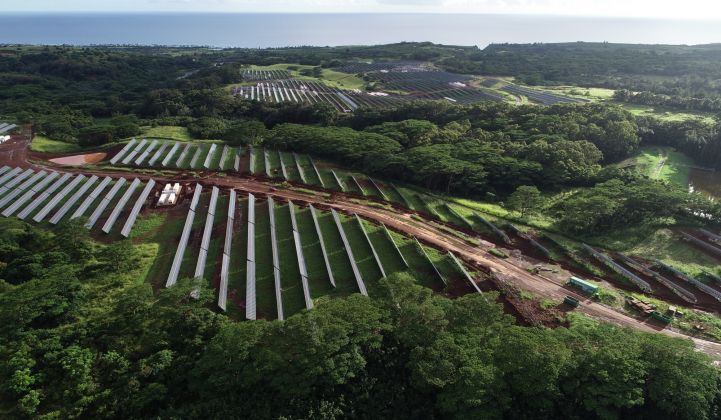
AES Corporation launched the world’s largest battery plant paired with solar generation Tuesday, on the Hawaiian island of Kauai.
This type of power plant produces cheap, clean energy and uses batteries to deliver power when it is most valuable, instead of just when the sun shines. That’s vital to decarbonizing the island grids of Hawaii, which struggle with too much solar power at midday but still rely on fossil-fueled peaker plants in the evening.
In the two years since AES announced the project, a flurry of headlines ensued as energy companies drove the price point for dispatchable solar successively lower. While the most attention-grabbing bids bank on several years of further battery cost declines, the Kauai plant is up and running right now.
The Kauai Island Utility Cooperative is finishing up commissioning for the Lawa’i Solar and Energy Storage Project, which combines 28 megawatts of solar photovoltaic capacity with a lithium-ion battery capable of storing 100 megawatt-hours.
The battery alone holds more energy than all but one other U.S. plant: the 120 megawatt-hour facility AES built in Escondido in 2017. Taken as a whole, Lawa’i’s storage capacity outranks any other operational solar-paired battery system in the world, according to Wood Mackenzie Power and Renewables. But the ever-growing solar-plus-storage project pipeline means that title won’t be safe for long.
“This market is growing at a phenomenal rate,” said AES President and CEO Andrés Gluski. “I think you’re going to see a whole lot less peaker plants.”
Solar power at night
AES owns and operates the plan on behalf of KIUC, under a power purchase agreement pegged at 11 cents per kilowatt-hour.
The plant delivers solar power when a standalone solar plant can’t: at night. That offsets the peaker plants that turn on for the evening peak; in Hawaii, those plants tend to run on imported oil, at considerable expense.
“We’re in the money any time you can dispatch to offset oil generation,” said Woody Rubin, president of AES Distributed Energy.
Lawa’i can crank a full output of 20 megawatts for five hours. With 100 megawatt-hours of stored energy, the battery can also operate more like a baseload plant, delivering a lower amount of power for more hours through the night until the sun comes back up. AES expects to offset 3.7 million gallons of diesel each year by dispatching more cost-effectively than the fossil fueled incumbents.
An additional capability, for special occasions: the plant can black start the overall grid if an outage knocks it out.
The battery technology allows many more use configurations than a standalone solar plant, which just produces electricity. As such, the process of testing out all the different functions has been “a fun time,” Rubin said.
“You open up the new toy and you start playing with it,” he said.
Clean energy breakthrough
With the new plant, Kauai will be able to operate for certain parts of the day entirely from renewables, Rubin said.
Meeting Hawaii’s legislative mandate of 100 percent renewable by 2045, though, requires more than midday solar abundance. The early solar-plus-storage plants (Tesla/SolarCity also built one on Kauai) proved that cheap solar power could serve the grid when needed rather than flooding it when there’s already enough power.
“There’s too much discussion about renewable energy, there’s not enough discussion about capacity,” Gluski said of decarbonization in general. “With batteries in place, it’s a game changer — you can produce very cheap energy and turn it into that 24/7 capacity.”
Now, KIUC will be able to serve up to 40 percent of evening peak power with stored solar energy, President and CEO David Bissell said in a statement.
Kauai’s pioneering projects have already inspired a wave of followers. AES is building another hybrid system at Pacific Missile Range Facility – Barking Sands Naval Base; it will combine 19.3 megawatts solar capacity with 70 megawatt-hour energy storage.
Just last week, the Hawaiian Electric Company asked regulators to approve seven new solar-storage plants across the islands of Hawai’i, Maui and O’ahu. That move confirmed that this type of resource will play an increasingly central role in Hawaii’s energy future. All but one of the proposed projects beat Lawa’i’s price per kilowatt-hour.
AES had two massive plants in that portfolio: one with 30 megawatts/120 megawatt-hours and one with 60 megawatts/240 megawatt-hours, both clocking in at 8 cents per kilowatt-hour.
The concept also made its way to the mainland, with 3.6 cent per kilowatt-hour median bids in Xcel’s Colorado solicitation, and 4.5 cent per kilowatt-hour hybrid system going to Tucson Electric Power. (The lower costs reflect several factors, include construction costs on mainland versus Hawaii, and relative size of the battery component compared to the solar capacity.)
It’s important to note that KIUC made the economics work as a relatively tiny company. It serves 65,000 customers with peak capacity of 125 megawatts. The new plant brings its generation mix to 50 percent renewable, well beyond most any other utility at this time.
“Look to KIUC as a vanguard in the energy transition,” said Daniel Finn-Foley, energy storage analyst at Wood Mackenzie Power & Renewables. “It made sense politically and economically there first, but that same stiff wind of change that swept Hawaii is approaching the mainland too.”
